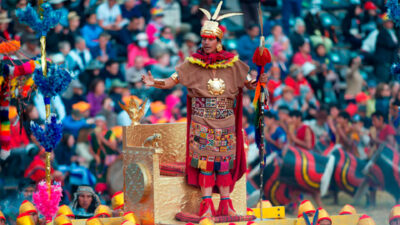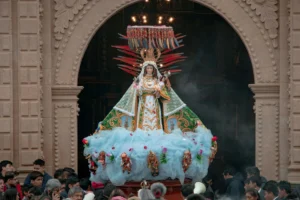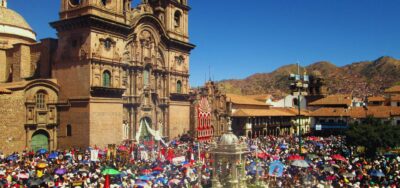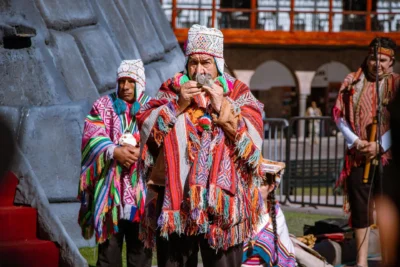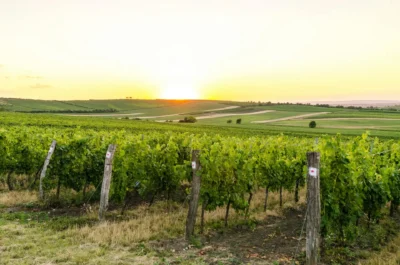The Feast of the Virgin of Candelaria, recognized as Intangible Cultural Heritage of Humanity by UNESCO, stands out as one of the most representative celebrations in Peru and Latin America. This event, which blends religious devotion with Andean cultural expressions, is celebrated annually in Puno, known as the “Folkloric Capital of Peru.”
Here at Machu Picchu Wayna, we will explore the origin, meaning, and various elements that make this festivity a unique experience.
Origin, history, and meaning of the Virgin of Candelaria
The festival in honor of “Mamacha Candelaria” in Puno dates back to the 16th century with the arrival of Spanish colonizers and Catholic evangelization. The image of the Virgin of Candelaria was brought to Peru on February 2, 1583, from Seville or Cádiz as part of the Christianization process. However, her worship began in 1392 in Tenerife, Spain, and spread to the American colonies due to travels between Europe and America.
In Puno, the veneration of the Virgin of Candelaria is linked to a pre-Hispanic agricultural ritual calendar, where celebrations included music and dance. During evangelization, the Spanish used local dances, such as the takis, to adapt indigenous traditions to Christian worship. This blend of beliefs, known as syncretism, gave rise to dances that today combine Christian and Andean elements, becoming an integral part of Puno’s culture.
Meaning
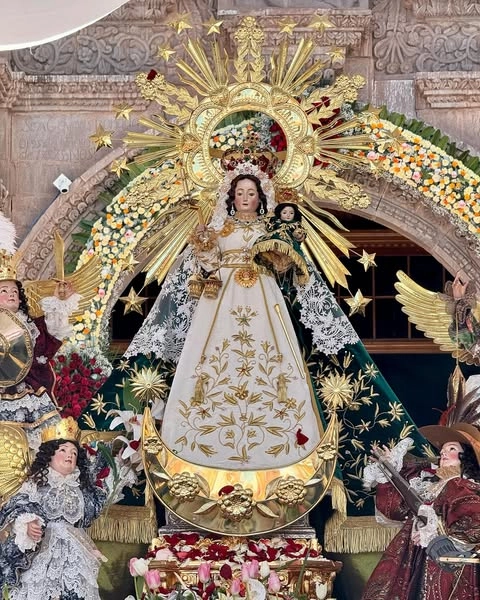
The Virgin of Candelaria is named after the lit candle she holds in her right hand, symbolizing light and purification. In the same hand, she carries a basket with two turtledoves, representing sacrifice and the purification of motherhood, according to Jewish tradition.
Additionally, in her left arm, she holds the child Jesus, alluding to Jesus’ presentation in the temple of Jerusalem, as described in the New Testament gospels.
The sanctuary of the Virgin of Candelaria
The Sanctuary of the Virgin of Candelaria, located in the heart of Puno, is the epicenter of the celebrations. This colonial temple, adorned with baroque altars and wooden carvings, is home to the venerated image of the Virgin (you can also visit these tourist places in Puno). During the festival, the sanctuary fills with flowers, candles, and offerings from the faithful, creating an atmosphere of devotion and spirituality that moves all present.
Traditions and customs of the festivity
The Feast of the Virgin of Candelaria is celebrated every February and lasts approximately two weeks. The traditions and customs of the festival in Puno are a mix of religious devotion and Andean cultural expressions. Some of the main ones include:
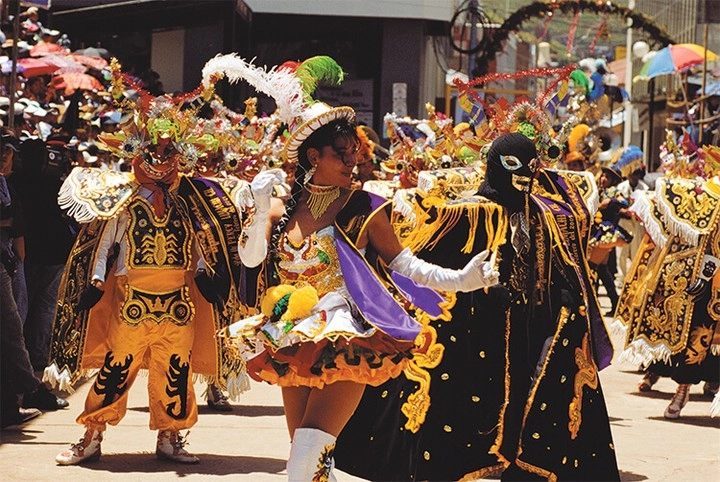
- The procession: The image of the Virgin of Candelaria is carried in procession through the main streets of Puno, accompanied by thousands of faithful who actively participate, carrying candles and singing religious hymns.
- Folkloric dances: Dances are a fundamental part of the festival. Dance groups participate in traditional performances such as the diablada, morenada, and sicuris, which combine indigenous and Christian elements.
- Mass in honor of the Virgin: The religious celebration begins with a mass in honor of the Virgin of Candelaria, where the faithful renew their devotion and participate in liturgical ceremonies.
- Veneration of the Virgin: People visit the Virgin of Candelaria in her sanctuary, paying homage with flowers, prayers, and offerings, asking for protection and blessings for their families and communities.
- The “Pujllay” or “Fiesta de la Candelaria”: The festival lasts several days, starting in early February. During this time, dance competitions, music contests, and social events take place, showcasing Puno’s cultural identity.
- Religious syncretism: The festival reflects the blend of Catholic beliefs with Andean traditions, such as the veneration of the apus (mountain spirits) and Pachamama (Mother Earth), integrating ancestral rites into the Christian celebration.
- Pachamama and offerings: During the festival, it is common to perform rituals in honor of Pachamama, offering food, drinks, and other elements to Mother Earth, asking for her protection and prosperity for the year.
- Traditional clothing: Participants, especially dancers, wear colorful and elaborate traditional outfits that represent various regions of the Andean highlands. Each costume has specific symbolism related to the community’s cultural and religious identity.
- Fireworks: During the festival, fireworks displays accompany the celebration, adding a festive touch to the occasion.
These traditions and customs are the essence of the Feast of the Virgin of Candelaria in Puno and reflect the deep connection between religious faith and the rich cultural heritage of Andean peoples.
Indigenous dances: Cultural expressions of Puno
The festival is famous for its indigenous dances, which represent the traditions of the Aymara and Quechua communities. These cultural expressions are a way to honor the Virgin and the ancestral roots of the Altiplano. Some of the most representative dances include:
- Diablada: Represents the struggle between good and evil, linked to the Virgin of Candelaria. Dancers, dressed as demons, perform to festive music.
- Morenada: Reflects the struggles of former black slaves in the mines. Dancers wear costumes representing enslaved people and dance to traditional music.
- Sicuris: Performed with sicus flutes, this dance symbolizes harmony among communities and gratitude to Pachamama for the harvests.
- Huayno: A couple’s dance with a cheerful rhythm, representing the daily life of Andean communities.
- Kullawada: Associated with the peoples of Lake Titicaca, this dance reflects the relationship with nature and lake traditions.
- Tinku: Represents ritual conflicts between villages, with intense movements symbolizing resistance and struggle.
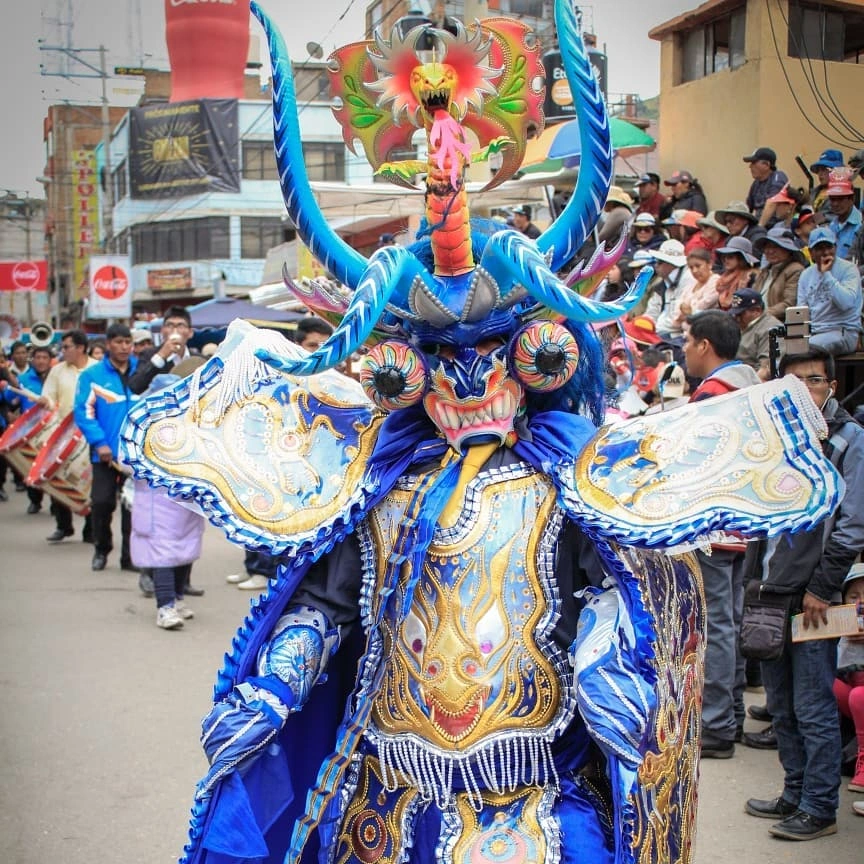
Rituals and meaning of the attire in the festivity
The Feast of the Virgin of Candelaria in Puno is a celebration that fuses deep religious traditions with indigenous cultural expressions, and attire plays a fundamental role in this commemoration.
Rituals associated with the attire
- Preparation and blessing of the costumes: Before the festival, participants carefully craft and prepare their costumes. It is common for costumes to be blessed in a special mass, symbolizing the union between faith and culture.
- Procession with traditional attire: During the procession in honor of the Virgin, the faithful wear their traditional outfits, showing respect and devotion. The attire becomes a visual offering to the Virgin and the community.
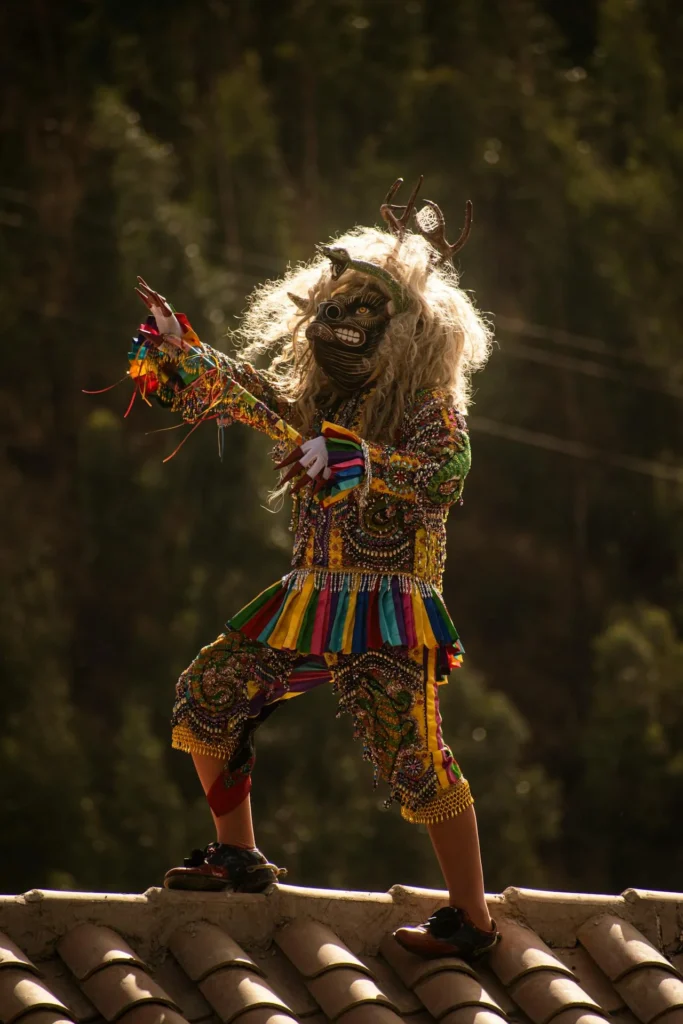
Meaning of the attire
- Symbols of cultural identity: Each costume reflects the identity and history of Andean communities. Colors, embroidery, and decorations represent elements of nature, ancestral beliefs, and the Andean worldview.
- Expression of religious devotion: The attire also symbolizes faith and devotion to the Virgin of Candelaria. The costumes, especially those of the dancers, are designed to honor the Virgin and express gratitude for her blessings.
- Cultural syncretism: The clothing is an example of the fusion between indigenous traditions and Spanish influences. Pre-Columbian elements combine with Christian symbols, creating a unique attire that reflects the region’s shared history.
Tourist experience in the festivity of the Virgin of Candelaria
The Feast of the Virgin of Candelaria is a unique opportunity for tourists to immerse themselves in Puno’s living culture. From religious processions to dance competitions, each activity offers an authentic and enriching experience.
Activities and main events for visitors
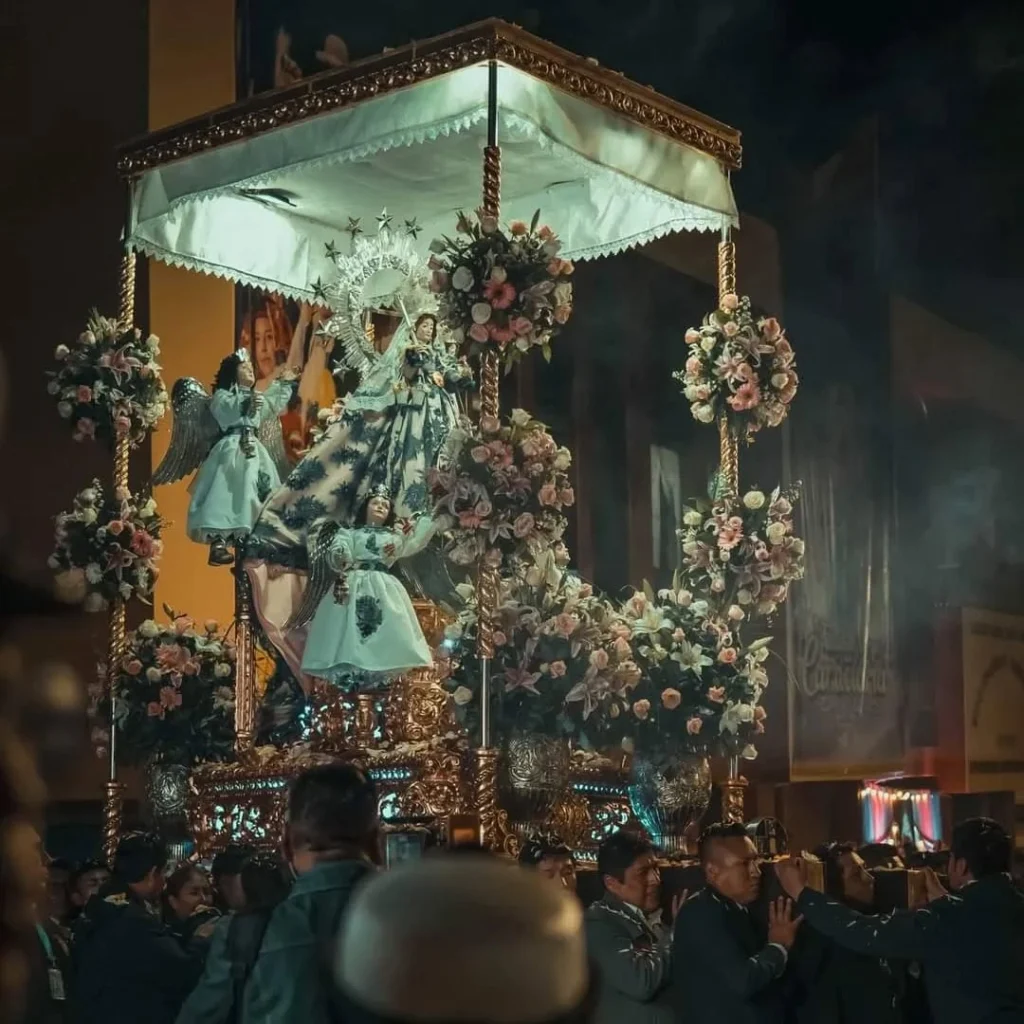
The Feast of the Virgin of Candelaria in Puno offers a wide range of religious and cultural activities, ideal for visitors. Among the main activities are:
- Religious processions: The festival begins with a dawn mass, followed by a procession through Puno’s streets, where the Virgin’s image is accompanied by dance and traditional music.
- Indigenous Dance Competition: In early February, a competition takes place where local groups perform dances that blend Catholic culture with indigenous traditions.
- Lighted Costume Parade: On February 9, 10, and 11, a parade is held where participants wear costumes adorned with bright lights and vibrant colors in honor of the festival.
- Parade in Honor of the Octave: On February 11, a parade showcases costumes and dances through Puno’s main streets.
- Gastronomic and Artisan Fairs: Visitors can try typical dishes like cuy al horno (baked guinea pig) and trucha frita (fried trout) and purchase local crafts.
- Folk Music Concerts: Throughout various locations in the city, folk music performances take place, allowing tourists to enjoy traditional melodies played by local musicians.
- Cultural Events and Exhibitions: In addition to religious activities, art and craft exhibitions are organized, providing visitors with a deeper insight into the culture and traditions of Puno.
These activities allow tourists to experience the culture and traditions of the region during the Feast of the Virgin of Candelaria.
Traditional gastronomy during the Celebration
During the festival, you will have the opportunity to taste local food. You will find food stalls serving traditional dishes of the region, such as chairo, caldo de cabeza, and rocoto relleno.
